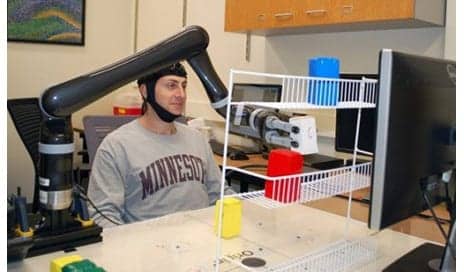
A participant in the research study at the University of Minnesota, fitted with a specialized noninvasive brain cap, moves a robotic arm by thinking about moving his own arms. (Photo courtesy of the University of Minnesota)
Researchers at the University of Minnesota report their successful implementation of a new noninvasive technique enabling eight test subjects to control a robotic arm with their minds.
The researchers note that their research could potentially be used with those who are paralyzed or have neurodegenerative diseases.
The technique, called electroencephalography (EEG) based brain-computer interface, records weak electrical activity of the subjects’ brain through a specialized, high-tech EEG cap fitted with 64 electrodes and converts the “thoughts” into action by advanced signal processing and machine learning, explains a media release from the University of Minnesota College of Science and Engineering.
The eight healthy human participants wore the EEG cap, then gradually learned to imagine moving their own arms without actually moving them to control a robotic arm in 3D space. They started from learning to control a virtual cursor on computer screen and then learned to control a robotic arm to reach and grasp objects in fixed locations on a table. Eventually, they were able to move the robotic arm to reach and grasp objects in random locations on a table and move objects from the table to a three-layer shelf by only thinking about these movements, the release continues.
“This is the first time in the world that people can operate a robotic arm to reach and grasp objects in a complex 3D environment using only their thoughts without a brain implant,” says Bin He, a University of Minnesota biomedical engineering professor and lead researcher on the study, in the release. “Just by imagining moving their arms, they were able to move the robotic arm.”
In terms of controlling the robotic arm to pick up objects in fixed locations, all eight participants achieved an above 80% success rate. In terms of moving objects from the table onto the shelf, the success rate was above 70%.”This is exciting, as all subjects accomplished the tasks using a completely noninvasive technique. We see a big potential for this research to help people who are paralyzed or have neurodegenerative diseases to become more independent without a need for surgical implants,” He continues.
The study was published recently in Scientific Reports.
[Source(s): University of Minnesota College of Science and Engineering, Science Daily]




